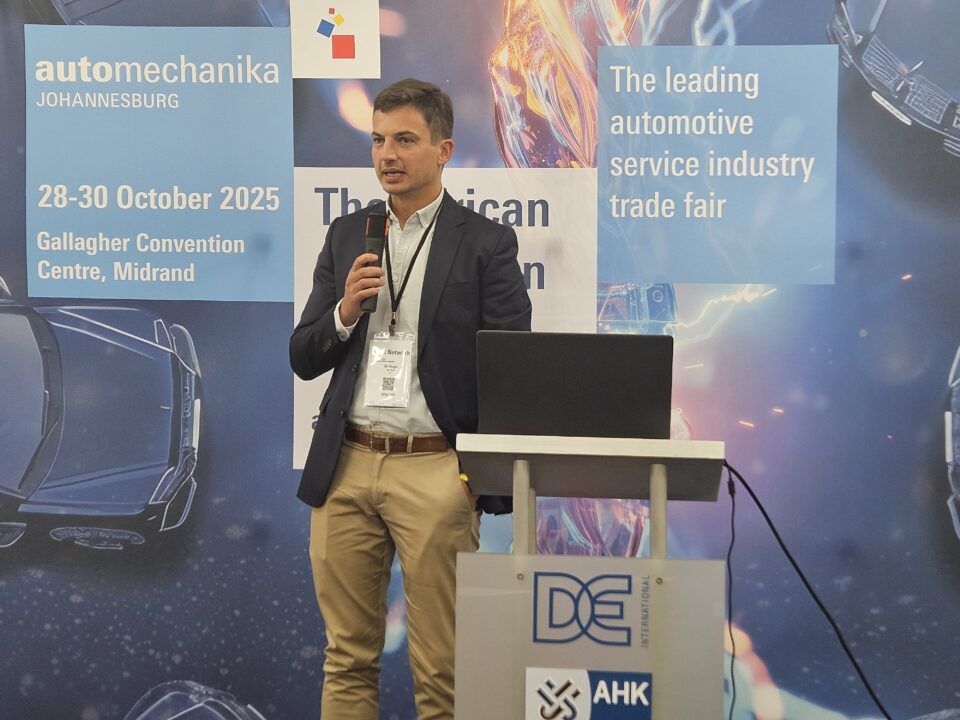On Friday, 31 January, prominent figures in the automotive industry met at the Southern African-German Chamber of Commerce and Industry in Johannesburg for a combined Automechanika CEO lunch and networking event.
The discussions focused on electric mobility, African market opportunities, and the transformation of South Africa’s automotive landscape. The event featured insights from prominent industry experts who addressed critical aspects of the automotive sector’s evolution, particularly focusing on electric vehicles (EV’s) and African market dynamics. The event commenced with introductory remarks by Michael Dehn, Managing Director of Messe Frankfurt South Africa, followed by the opening address by Simone Pohl, CEO of AHK Southern Africa.
Delegates then listened attentively to keynote presentations by Hiten Parmar, Executive Director at The Electric Mission; Dr. Hugo van Wyk, Associate Director at EY; Greg Cress, Principal Director of Automotive and eMobility at Accenture South Africa; and Lightstone’s Chief Analytics Officer, Paul-Roux de Kock.
Invaluable Insights
Parmer revealed that South Africa is among the top 10 countries worldwide for the ratio of public charging stations to the number of EV’s, with charging infrastructure showing strong growth. He emphasised the active involvement of multiple stakeholders, including traditional oil companies, in the expansion of charging networks.
Dr van Wyk then provided an analysis of African market opportunities. His presentation was supported by data from Ernst & Young’s Grow Beyond Borders tool, which evaluates key indicators such as access to electricity, GDP, global penetration and population statistics. Dr van Wyk’s presentation underscored the continent’s substantial resource potential, while acknowledging challenges related to ease of doing business, political risk, and infrastructure quality.
Cress revealed two potential scenarios for New Energy Vehicle (NEV) adoption in South Africa from 2025 to 2035, which compared how different policy approaches might affect NEV uptake, particularly for vehicles under R500,000.
Scenario 1 (using the current status quo) shows what might happen without tax holidays or incentives for NEVs). In this case, NEV adoption grows more slowly, reaching about 750,000 vehicles by 2035, with BEVs making up 5.5% of domestic car sales. Scenario 2 (using accelerated incentives) demonstrates what could happen with tax holidays and consumer incentives for NEVs, resulting in a more aggressive adoption rate reaching about 915,000 vehicles by 2035, with BEVs comprising 5.9% of domestic sales.
Both scenarios track three types of vehicles: Traditional Hybrids (HEV), Plug-in Hybrids (PHEV), and Battery Electric Vehicles (BEV), with HEVs maintaining the largest share in both scenarios, but BEVs showing significantly higher adoption in Scenario 2 (353,579 vehicles) compared to Scenario 1 (195,354 vehicles).
Cress pinpointed the importance of safeguarding employment opportunities, pointing out that major OEMs are implementing digital readiness programmes to prepare their workforce for the transition.
De Kock subsequently shared market data showing the dominance of crossovers and SUVs in South Africa’s vehicle market. His presentation revealed that just under 40% of cars sold in South Africa are assembled locally, with a projected 5% growth in new vehicle sales forecast for the coming year. He underscored that affordability remains the primary driver in the South African market, particularly with the recent influx of new brands from China over the last three years.
Welcome Return
The event concluded with Tracy Gounden, Business Development & Portfolio Director at Messe Frankfurt SA, announcing upcoming road shows scheduled for April across various African countries, including new additions in Botswana and Namibia. A notable development highlighted was the return of the German pavilion to the new venue of the Gallagher Convention Centre for the 2025 event.
Dehn noted that the CEO lunch and networking event exemplified the collaborative spirit that drives Automechanika forward. “As we prepare for our October showcase at the Gallagher Convention Centre in Midrand, it is inspiring to see industry leaders coming together to address crucial topics like e-mobility, African market expansion, and workforce development. The calibre of today’s discussions further solidifies South Africa’s standing as a pivotal centre for automotive innovation on the continent,” he remarked. For more information about exhibiting or attending Automechanika Johannesburg 2025, visit www.automechanikasa.co.za or contact Tracy Gounden at tracy.gounden@za.messefrankfurt.com




